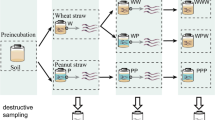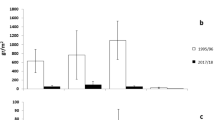Abstract
In aquatic ecosystems, microorganisms and invertebrates provide critical links between plant detritus and higher trophic levels. Atyaephyra desmarestii is an omnivorous decapod that inhabits freshwaters and exhibits high tolerance to temperature oscillations and high ability to colonize new habitats. Although A. desmarestii is able to ingest a variety of foods, few studies have been conducted to elucidate the role of this freshwater shrimp on detritus breakdown in streams. In this study, A. desmarestii was allowed to feed on conditioned or unconditioned alder and eucalyptus leaves in microcosms with or without access to its fecal pellets. At the end of the experiment, total body length of the animals was measured, and the remaining leaves and fecal pellets were used for dry mass quantification and assessment of bacterial and fungal diversity by denaturing gradient gel electrophoresis (DGGE). Cluster analyses of DGGE fingerprints indicated that the major differences in microbial communities on leaves were between leaf types, while on fecal pellets were between conditioned and unconditioned leaves. However, the consumption rate by the shrimp did not differ between leaf types, and was significantly higher on leaves conditioned by microorganisms and in treatments without access to feces. In treatments without access to feces, the production of feces and fine particulate organic matter was also significantly higher for conditioned leaves. Overall, our results support the feeding plasticity of A. desmarestii and its potential role in plant litter breakdown in streams. This might have implications for maintaining stream ecosystem functioning, particularly if more vulnerable shredders decline.





Similar content being viewed by others
References
Abelho, M. & M. A. S. Graça, 1996. Effects of eucalyptus afforestation on leaf litter dynamics and macroinvertebrate community structure of streams in central Portugal. Hydrobiologia 324: 195–204.
Allan, J. D. & M. M. Castillo, 2007. Stream Ecology. Springer, Dordrecht.
Arsuffi, T. L. & K. Suberkropp, 1988. Effects of fungal mycelia and enzymatically degraded leaves on feeding and performance of caddisfly (Trichoptera) larvae. Journal of the North American Benthological Society 7: 205–211.
Bärlocher, F., 1985. The role of fungi in the nutrition of stream invertebrates. Botanical Journal of the Linnean Society 91: 83–94.
Bärlocher, F., 2005. Freshwater fungal communities. In Deighton, J., P. Oudemans & J. White (eds), The Fungal Community: its Organization and Role in the Ecosystem. Taylor and Francis, CRC Press, Boca Raton: 39–59.
Bärlocher, F., 2009. Reproduction and dispersal in aquatic hyphomycetes. Mycoscience 50: 3–8.
Callisto, M., 2006. Some laboratory evidences about the Mediterranean shrimp Atyaephyra desmarestii feeding on Alnus glutinosa (L.) Gaertn leaf detritus. Acta Limnologica Brasiliensia 18: 225–228.
Canhoto, C. & M. A. S. Graça, 1995. Food value of introduced eucalypt leaves for a Mediterranean stream detritivore: Tipula lateralis. Freshwater Biology 34: 209–214.
Canhoto, C. & M. A. S. Graça, 1999. Leaf barriers to fungal colonization and shredders (Tipula lateralis) consumption of decomposing Eucalyptus globulus. Microbial Ecology 37: 163–172.
Covich, A. P., T. A. Crowl & F. N. Scatena, 2003. Effects of extreme low flows on freshwater shrimps in a perennial tropical stream. Freshwater Biology 48: 1199–1206.
Crowl, T. A., W. H. McDowell, A. P. Covich & S. L. Johnson, 2001. Freshwater shrimp effects on detrital processing and nutrients in a tropical headwater stream. Ecology 82: 775–783.
Cummins, K. W. & M. J. Klug, 1979. Feeding ecology of stream invertebrates. Annual Review of Ecology and Systematics 10: 147–172.
Das, M., T. V. Royer & L. G. Leff, 2007. Diversity of fungi, bacteria, and actinomycetes on leaves decomposing in a stream. Applied and Environmental Microbiology 73: 756–767.
Duarte, S., C. Pascoal, A. Alves, A. Correia & F. Cássio, 2010. Assessing the dynamic of microbial communities during leaf decomposition in a low-order stream by microscopic and molecular techniques. Microbiological Research 165: 351–362.
Dudgeon, D., 2008. Tropical Stream Ecology. Academic Press, Elsevier.
Ferreira, V., A. L. Gonçalves, D. L. Godbold & C. Canhoto, 2010. Effect of increased atmospheric CO2 on the performance of an aquatic detritivore through changes in water temperature and litter quality. Global Change Biology 16: 3284–3296.
Fidalgo, M. L., 1983. Oxygen consumption in Atyaephyra desmaresti (Millet Crustacea, Decapoda, Natantia). Publicações do Instituto de Zoologia. “Dr. Augusto Nobre” 176: 1–8.
Fidalgo, M. L., 1985. About the assimilation efficiency of the freshwater shrimp, Atyaephyra desmarestii Millet (Crustacea, Decapoda). Verhandlungen der internationalen Vereinigung für Limnologie 22: 3227–3229.
Fidalgo, M. L., 1989. Biology of the freshwater shrimp Atyaephyra desmarestii Millet (Decapoda: Natantia) in the river Douro, Portugal. I. Life cycle and individual growth. Archiv für Hydrobiologie 116: 97–106.
Fidalgo, M. L., 1990a. Assimilation efficiency of the freshwater shrimp Atyaephyra desmaresti Millet fed Microcystis aeruginosa Kutz. Publicações do Instituto de Zoologia “Dr. Augusto Nobre” 221: 1–6.
Fidalgo, M. L., 1990b. Biology of the freshwater shrimp Atyaephyra desmarestii Millet (Decapoda: Natantia) in the river Douro, Portugal. II: feeding rate and assimilation efficiency. Publicações do Instituto de Zoologia “Dr. Augusto Nobre” 223: 1–19.
Fidalgo, M. L. & A. Gerhardt, 2003. Distribution of the freshwater shrimp, Atyaephyra desmarestii (Millet, 1831) in Portugal (Decapoda, Natantia). Crustaceana 75: 1375–1385.
Frankenberg, D. & K. L. Smith Jr, 1967. Coprophagy in marine animals. Limnology and Oceanography 12: 443–449.
García-Berthou, E. & R. Moreno-Amich, 2000. Food of introduced pumpkinseed sunfish: ontogenic diet shift and seasonal variation. Journal of Fish Biology 57: 29–40.
Gauthier, H., 1924. Recherches sur le développement larvaire d’Atyaephyra desmaresti (Millet, 1831) (Décapodes, Natantia, Caridea, Atyidés). Bulletin de la Société d’Histoire Naturelle de l’Afrique du Nord 15: 337–376.
Graça, M. A. S., 2001. The role of invertebrates on leaf litter decomposition in streams – a review. International Review of Hydrobiology 86: 383–393.
Graça, M. A. S., C. Cressa, M. O. Gessner, M. J. Feio, K. A. Callies & C. Barrios, 2001. Food quality, feeding preferences, survival and growth of shredders from temperate and tropical streams. Freshwater Biology 46: 947–957.
Graça, M. A. S., J. Pozo, C. Canhoto & A. Elosegi, 2002. Effects of Eucalyptus plantations on detritus decomposers, and detritivores in streams. The ScientificWorldJournal 2: 1173–1185.
Janssens de Bisthoven, L., A. Gerhardt, K. Guhr & A. M. V. M. Soares, 2006. Behavioral changes and acute toxiciy to the freshwater shrimp Atyaephyra desmarestii Millet (Decapoda: Natantia) from exposure to acid mine drainage. Ecotoxicology 15: 215–227.
Muñoz, J. E. G., A. Rodríguez, J. E. G. Raso & J. A. Cuesta, 2009. Genetic evidence for cryptic speciation in the freshwater shrimp genus Atyaephyra de Brito Capello (Crustacea, Decapoda, Atyidae). Zootaxa 2025: 32–42.
Nikolcheva, L. G. & F. Bärlocher, 2005. Seasonal and substrate preferences of fungi colonizing leaves in streams: traditional versus molecular evidence. Environmental Microbiology 7: 270–280.
Oscoz, J. & C. Durán, 2005. Contribution to the knowledge of the freshwater shrimp, Atyaephyra desmaresti (Millet, 1831) (Decapoda, Natantia), in the Ebro basin (Spain). Zoologica Baetica 16: 155–159.
Pascoal, C., M. Pinho, F. Cássio & P. Gomes, 2003. Assessing structural and functional ecosystem condition using leaf breakdown: studies on a polluted river. Freshwater Biology 48: 2033–2044.
Pascoal, C., F. Cássio, A. Marcotegui, B. Sanz & P. Gomes, 2005. Role of fungi, bacteria, and invertebrates in leaf litter breakdown in a polluted river. Journal of the North American Benthological Society 24: 784–797.
Straka, M. & J. Špaček, 2009. First record of alien crustaceans Atyaephyra desmarestii (Millet, 1831) and Jaera istri Veuille, 1979 from the Czech Republic. Aquatic Invasions 4: 397–399.
Suberkropp, K., 1998. Microorganisms and organic matter decomposition. In Naiman, R. J. & R. E. Bilby (eds), River Ecology and Management: lessons from the Pacific Coastal Ecoregion. Springer, New York: 120–143.
Van den Brink, F. W. B. & G. Van der Velde, 1986. Observations on the seasonal and yearly occurrence and the distribution of Atyaephyra desmaresti (Millet, 1831) (Crustacea, Decapoda, Natantia) in the Netherlands. Hydrobiological Bulletin 19: 193–198.
Wotton, R. S., 1980. Coprophagy as an economic feeding tactic in black fly larvae. Oikos 34: 282–286.
Yule, C. M., M. Y. Leong, K. C. Liew, L. Ratnarajah, K. Schmidt, H. M. Wong, R. G. Pearson & L. Boyero, 2009. Shredders in Malaysia: abundance and richness are higher in cool upland tropical streams. Journal of the North American Benthological Society 28: 404–415.
Acknowledgments
The Portuguese Foundation for the Science and Technology supported S. Duarte (SFRH/BPD/47574/2008).
Author information
Authors and Affiliations
Corresponding author
Additional information
Handling editor: Núria Bonada
Rights and permissions
About this article
Cite this article
Duarte, S., Fidalgo, M.L., Pascoal, C. et al. The role of the freshwater shrimp Atyaephyra desmarestii in leaf litter breakdown in streams. Hydrobiologia 680, 149–157 (2012). https://doi.org/10.1007/s10750-011-0912-0
Received:
Revised:
Accepted:
Published:
Issue Date:
DOI: https://doi.org/10.1007/s10750-011-0912-0




